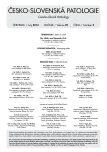-
Medical journals
- Career
Signs of self-inflicted wounds; how accurate they are
Authors: Nasim Zamani
Authors‘ workplace: Department of Forensic Medicine and Clinical Toxicology, Tehran University of Medical Sciences, Tehran, Iran
Published in: Soud Lék., 58, 2013, No. 3, p. 47
Category: Letter to Editor
Overview
Keywords:
self-inflicted wounds – forensic – signsDear Editor:
Differentiating the intentionally self-inflected wounds from the real ones is an important point in the clinical field of forensic medicine. As described in one of the most famous forensic textbooks - Knight’s Forensic Pathology - the most important clinical signs of these intentionally self-inflicted wounds include left-side injuries in the right-handed patients (especially in the areas available to the patient), regular, superficial, and parallel wounds avoiding vital and sensitive areas, and irrelevant garment cuts not matching the injuries in position and direction (1). Seeing a horizontal tear on the garment and a vertical wound beneath, a forensic specialist generally thinks of an intentional self-inflicted wound. I, however, present a case of real injury with all these features.
The patient was actually a close relative of mine who hurt himself while handling a 1x1.5 meter, 8-mm thick glass leaning to the wall. Wile trying to remove the glass, it slid, fell on the patient’s left arm and then dropped, tore the left sleeve of his shirt horizontally and made two parallel vertical superficial wounds on his arm. I would like to tell that even such famous signs that are considered as signs of intentional self-inflicted injuries, taught by famous forensic textbooks worldwide, and considered in the management of those referring to the forensic organizations for examination, are not a hundred percent correct and may all be present in a case of real injury. A specialist in Forensic Medicine should, therefore, always keep such possibilities in his/her mind while confronting a patient with possible self-inflicted wounds.
Reviewer’s comment:
The necessity to consider all circumstances in the case of suspicion on self-inflicted injury is not discuss.
Correspondence address:
Nasim Zamani, MD
Department of Clinical Toxicology
Logman Hakin Hospital, Shahid
Beheshti University of Medical Sciences, Teheran, Iran
tel.: 00989122059290
e-mail: nasim.zamani@gmail.com
Sources
1. Saukko P, Knight B. Self-inflicted injury. In: Saukko P, Knight B, eds. Knight’s Forensic Pathology. London; Edward Arnold; 2004 : 235–44.
Labels
Anatomical pathology Forensic medical examiner Toxicology
Article was published inForensic Medicine

2013 Issue 3-
All articles in this issue
- Traumatic changes of intrathoracic organs due to external mechanical cardiopulmonary resuscitation. Case reports
- Gender differences in alcohol affection on an individual
- Death due to Arrhythmogenic Right Ventricular Dysplasia: A case report
- Sudden death due to high take-off right coronary artery
- Signs of self-inflicted wounds; how accurate they are
- Forensic Medicine
- Journal archive
- Current issue
- Online only
- About the journal
Most read in this issue- Traumatic changes of intrathoracic organs due to external mechanical cardiopulmonary resuscitation. Case reports
- Gender differences in alcohol affection on an individual
- Sudden death due to high take-off right coronary artery
- Signs of self-inflicted wounds; how accurate they are
Login#ADS_BOTTOM_SCRIPTS#Forgotten passwordEnter the email address that you registered with. We will send you instructions on how to set a new password.
- Career

